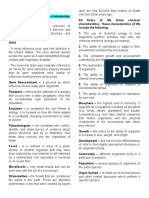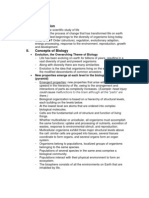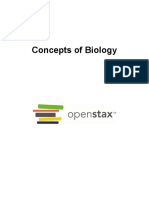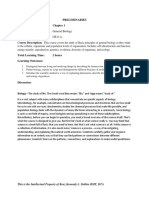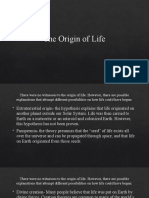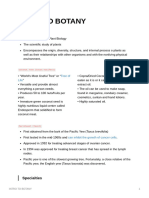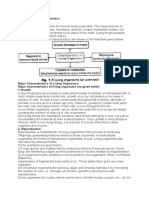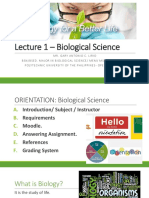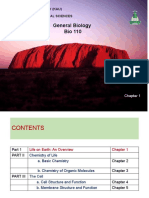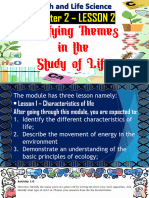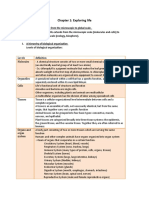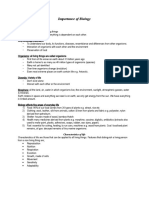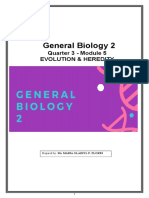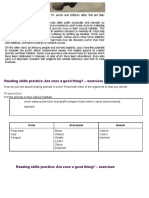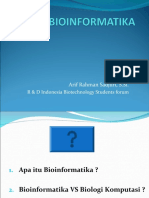0 ratings0% found this document useful (0 votes)
67 views1.1 What Is Life? Characteristics of Living Systems
1.1 What Is Life? Characteristics of Living Systems
Uploaded by
spencer_jordan_2This document provides an overview of key characteristics of living systems and biological evolution. It discusses how living things must gather energy and materials to grow and reproduce, and how their structure and function can change over generations in response to the environment. It describes DNA and how genetic mutations introduce variation that natural selection can act upon to drive evolutionary change over time, resulting in adaptations that help organisms survive and reproduce. The document also introduces taxonomy and how biologists classify living things into hierarchical groups like domains, kingdoms, and species based on their evolutionary relationships.
Copyright:
Attribution Non-Commercial (BY-NC)
Available Formats
Download as DOCX, PDF, TXT or read online from Scribd
1.1 What Is Life? Characteristics of Living Systems
1.1 What Is Life? Characteristics of Living Systems
Uploaded by
spencer_jordan_20 ratings0% found this document useful (0 votes)
67 views6 pagesThis document provides an overview of key characteristics of living systems and biological evolution. It discusses how living things must gather energy and materials to grow and reproduce, and how their structure and function can change over generations in response to the environment. It describes DNA and how genetic mutations introduce variation that natural selection can act upon to drive evolutionary change over time, resulting in adaptations that help organisms survive and reproduce. The document also introduces taxonomy and how biologists classify living things into hierarchical groups like domains, kingdoms, and species based on their evolutionary relationships.
Original Title
Chapter 1
Copyright
© Attribution Non-Commercial (BY-NC)
Available Formats
DOCX, PDF, TXT or read online from Scribd
Share this document
Did you find this document useful?
Is this content inappropriate?
This document provides an overview of key characteristics of living systems and biological evolution. It discusses how living things must gather energy and materials to grow and reproduce, and how their structure and function can change over generations in response to the environment. It describes DNA and how genetic mutations introduce variation that natural selection can act upon to drive evolutionary change over time, resulting in adaptations that help organisms survive and reproduce. The document also introduces taxonomy and how biologists classify living things into hierarchical groups like domains, kingdoms, and species based on their evolutionary relationships.
Copyright:
Attribution Non-Commercial (BY-NC)
Available Formats
Download as DOCX, PDF, TXT or read online from Scribd
Download as docx, pdf, or txt
0 ratings0% found this document useful (0 votes)
67 views6 pages1.1 What Is Life? Characteristics of Living Systems
1.1 What Is Life? Characteristics of Living Systems
Uploaded by
spencer_jordan_2This document provides an overview of key characteristics of living systems and biological evolution. It discusses how living things must gather energy and materials to grow and reproduce, and how their structure and function can change over generations in response to the environment. It describes DNA and how genetic mutations introduce variation that natural selection can act upon to drive evolutionary change over time, resulting in adaptations that help organisms survive and reproduce. The document also introduces taxonomy and how biologists classify living things into hierarchical groups like domains, kingdoms, and species based on their evolutionary relationships.
Copyright:
Attribution Non-Commercial (BY-NC)
Available Formats
Download as DOCX, PDF, TXT or read online from Scribd
Download as docx, pdf, or txt
You are on page 1of 6
CHAPTER 1
1.1 What is Life? Characteristics of Living Systems
The difference between living and nonliving systems depends not only on
the kinds of atoms and molecules present but also on their organization
and their interactions
o Living organisms must gather energy and materials from their
surroundings to build new biological molecules, grow in size,
maintain and repair their parts and produce offspring.
o Must also respond to environmental changes by altering their
chemistry and activity in ways that allow them to survive
o Structure and function of living systems often change with
generations
Emergent properties = characteristics that depend on the level of
organization of matter, but do not exist at lower levels of organization
Organization of life extends to several levels of hierarchy
o Cell (smallest unit with the capacity to live and reproduce,
independently or as part of a multicellular organism)
Lowest level of biological organization that can survive and
reproduce
EMERGENT PROPERTY: cannot be broken apart
o Multicellular Organism (individual consisting of interdependent
cells)
Opposite of unicellular organisms such as bacteria and
protozoans
Their cells live in tightly coordinated groups and are so
interdependent that they cannot survive on their own
EMERGENT PROPERTY: “humans can learn biology” (?)
o Population (group of individuals of the same kind that occupy the
same area)
Group of unicellular and multicellular organisms
EMERGENT PROPERY: characteristics such as birth or
death rate
o Community (populations of all species occupying the same area)
The bacteria, penguins, fishes, seals, whales and other
organisms that live along the coast of Antarctica taken
together, make up a community
o Ecosystem (group of communities interacting with their shared
physical environment)
Includes the community and the nonliving environmental
factors
Ex: forest ecosystem is animals, soil, dirt, water, air, ect.
o Biosphere (all regions of Earth’s crust, waters and atmosphere that
sustain life)
Deoxyribonucleic acid (DNA)
o Large, double-stranded helical molecule that contains instructions
for assembling a living organism from simpler molecules
o Molecular building blocks arranged differently in each of these
organisms, producing differences in their appearance and function
o Information in DNA is copied into molecules of a related substance,
ribonucleic acid (RNA), which then directs the production of
different protein molecules
o Proteins carry out most of the activities, including synthesis (Fig.
1.4)
Metabolism describes the ability of a cell or organism to extract energy to
maintain itself, grow and reproduce
o Cells carry out chemical reactions that assemble, alter and
disassemble molecules
o EX photosynthesis: electromagnetic energy in sunlight is absorbed
and converted into chemical energy; the cells of the plant store
some chemical energy in sugars and starches and use the rest to
manufacture other biological molecules
o EX cellular respiration: complex biological molecules are broken
down with oxygen, releasing some of their energy content for
cellular activities
Energy flows and matter cycles through living systems
o Primary producers – photosynthetic organisms
o Consumers – directly or indirectly feed on the complex molecules
manufactured by pants
o Decomposers – feed on the remains of dead organisms, breaking
down complex biological molecules into simpler raw materials (Fig.
1.6)
Although heat energy can be used by some animals to maintain body
temperature, it cannot sustain other life processes. By contrast, matter
cycles between living organisms and the nonliving components of the
biosphere, to be used again and again
All objects, whether living or nonliving, respond to changes in the
environment but only living organisms have the ability to detect
environmental change (i.e. a rock heating under the sun and cooling at
night)
o Shivering when cold/temperature regulation
o Homeostasis = a steady internal condition maintained by responses
that compensate for changes in the external environment
Reproduction through inheritance of DNA
Multicellular organisms also undergo a process of development, a series
of programmed changes encoded in DNA, through which a fertilized egg
divides into many cells that ultimately are transformed into an adult (ex.
development of the moth)
o These sequential stages through which individuals develop, grow,
maintain and reproduce are known as the life cycle
Populations of all organisms change from one generation to the next,
because some individuals experience changes in their DNA and they pass
these modified instructions along to their offspring (biological evolution)
1.2 Biological Evolution
All research in biology is undertaken with the knowledge that biological
evolution has shaped life on Earth
Our understanding of the evolutionary process reveals several truths
about the living world:
o All populations change over time
o All organisms are related through a shared ancestry
o Evolution has produced the diversity that exists today
Darwin and Wallace explained how populations of organisms change
through time
o Darwin
Extinct fossils that resemble current animals with similar
traits
Organisms change from one form to another over time
Studied domesticated animals—especially pigeons
Darwin noted that pigeon breeders who wanted a bird
to have a specific trait would only mate the birds that
had the trait they wanted to the bad characteristic
would be eliminated—known as artificial selection (the
equivalent of nature’s natural selection)
o Wallace
Variety of plants and animals in the Amazon basin and
Malaysia
o Conclusions explaining biological evolution
Most organisms can produce numerous offspring, but
environmental factors limit the number that actually survive
and reproduce
Heritable variations allow for some individuals to compete
more successfully for resources
These successful individuals somehow pass the favorable
characteristics to their offspring
As a result, the favorable traits become more common in the
next generation
o Although they understood the importance of variability, they could
not explain how these variations came to be
Mutations in DNA are the raw materials that allow evolutionary change
o DNA is organized into functional unites called genes and each gene
contains the code for a protein molecule or one of its parts
o Variability arises through mutation (random changes in string of
DNA)
o Many mutations are neutral
Adaptations enable organisms to survive and reproduce in the
environments where they live
o Favorable mutations may produce adaptations (characteristics that
help an organism survive longer or reproduce more under a
particular set of environmental conditions, i.e. camouflage/cryptic
coloration in rock pocket mouse)
o Michael W. Nachman & Hopi E. Hoekstra
Research on genetic mutations that produce adaptations
Found that nearly all the dark mice were found on rocks and
light mice found in the sand
Mc1r gene
1.3 Biodiversity
Fig 1. 11
Scientists have developed classification systems that attempt to arrange
organisms, living and dead, into groups that reflect their relationships and
evolutionary origins
o (BIGGEST) Domain Kingdom Phylum Class Order
Family Genus Species (SMALLEST)
Biologists consider the species to be a fundamental unit in a hierarchy of
categories
o Most biologists consider the species to be the most fundamental
grouping in the diversity of life
o Species = a group of populations in which the individuals are so
closely related in structure, biochemistry and behavior that they can
successfully interbreed (EX: Dalmatians)
o Genus = group of similar species that share recent common
ancestry (EX: dogs)
o Each species is assigned a two-part scientific name; the first part
identifies the genus and the second is the particular species
Biologists classify organisms into three domains and several kingdoms
o Three domains: Bacteria, Archaea and Eukarya
Bacteria and Archaea are prokaryotes (no nucleus)
Eukarya are eukaryotes (have nucleus)
The nucleus and other specialized internal compartments of
eukaryotic cells are called organelles
o The Domain Bacteria
Unicellular organisms
Generally visible only under the microscope
Live as producers and decomposers
Share a relatively simple cellular organization of DNA and
internal structure with the archaea and photosynthesis is
unique to this domain
o The Domain Archaea
Similar to bacteria (unicellular, microscopic, live as
producers and decomposers)
Inhabit extreme environments (hot springs, salty ponds, ect.)
Photosynthesis unique to their own domain
Some molecular and biochemical characteristics typical of
eukaryotes, including DNA and RNA organization/protein
synthesis
o The Domain Eukarya
All remaining organisms on Earth
Four kingdoms: Protoctista, Plantae, Fungi, Animalia
The Kingdom Protoctista
Single-celled and multicellular
Primarily unicellular and algae
Consumers and decomposers
The Kingdom Plantae
Multicellular organisms that (with a few exceptions)
carry out photosynthesis
Producers
Except for their reproductive cells (pollen and seeds)
they stay put
The Kingdom Fungi
Unicellular and multicellular species
Yeasts and molds
Decomposers
The Kingdom Animalia
Multicellular organisms tat live as consumers by
ingesting organisms in all three domains
Motility – the ability to move actively from one place to
another during some stage of their life cycles
1.4 Biological Research
Importance of scientific method
Attitude of inquiry and skepticism
Biologists confront the unknown by conducting basic and applied research
o Basic research – search for explanations about natural phenomena
to satisfy their own curiosity and to advance our collective
knowledge of living systems
o Applied research – goal of solving specific practical problems
Biologists conduct research by collecting observational and experimental
data
o Observational data – basic information on biological structures or
the details of biological processes (a.k.a. descriptive science)
o Experimental data – information that describes the result of a
careful manipulation of the system under study
Researchers often test hypotheses with controlled experiments
o Null hypothesis = a statement of what they would see if the
hypothesis being tested was not correct
o Alternative hypothesis = another reason why the experiment turned
out the way it did
o VOCAB: hypothesis, variables, predictions, the control,
experimental variable
o Replicates = multiple subjects that receive either the same
experimental treatment or the same control treatment
When controlled experiments are unfeasible, researchers use null
hypotheses to evaluate observational data
o Hertz’s study of lizard species and their thermoregulatory behaviors
o Fig 1.15
Biologists often use model organisms to study fundamental biological
processes
o Model organisms have rapid development, short life cycles and
small adult size
o EX: Escherichia coli showed the mechanisms that control whether
the information in any particular gene is used to manufacture a
protein molecule
Molecular techniques have revolutionized biological research
o Beadle and Tatum used bread as a model organism to show genes
provide the instructions for constructing certain proteins
o Watson and Crick determined the structure of DNA
o DNA “fingerprinting”
o Biotechnology = manipulation of living organisms to produce useful
products has revolutionized the pharmaceutical industry
Scientific theories are grand ideas that have stood the test of time
o When every conceivable test has confirmed a hypothesis that
addresses many broad questions, it may become regarded as a
scientific theory
**Self-Test Questions and Review on pgs. 19, 20**
You might also like
- Bio 101 Chapter 1 NotesDocument3 pagesBio 101 Chapter 1 NotesAndrew100% (1)
- Biology NotesDocument32 pagesBiology NotesTaylor BonnetNo ratings yet
- Introduction To Biology Short Question and AnswersDocument218 pagesIntroduction To Biology Short Question and AnswersNadeem ArainNo ratings yet
- Introduction To Biology Short Question and Answers: Q. Define Biology. Explain Its Branches. BiologyDocument7 pagesIntroduction To Biology Short Question and Answers: Q. Define Biology. Explain Its Branches. BiologyNadeem ArainNo ratings yet
- XI Biology (Sir Nasim Zulfiqar)Document217 pagesXI Biology (Sir Nasim Zulfiqar)Ansari Ansari'sNo ratings yet
- Xi Bio Note - Newton - Homelander GroupDocument176 pagesXi Bio Note - Newton - Homelander Groupnolepo4382No ratings yet
- Copy of Copy of Unit B Populations and Evolution ECOLOGY PPTDocument53 pagesCopy of Copy of Unit B Populations and Evolution ECOLOGY PPT2202371No ratings yet
- Lesson 2 - Unifying Themes in The Study of LifeDocument5 pagesLesson 2 - Unifying Themes in The Study of LifeMelvin CarranzaNo ratings yet
- The Study of LifeDocument34 pagesThe Study of LifebmuhindoNo ratings yet
- Define BiologyDocument11 pagesDefine BiologyPatricia PaezNo ratings yet
- Earth and Life Science ReviewerDocument6 pagesEarth and Life Science ReviewerAndrea MacatangayNo ratings yet
- Unifying Themes in The Study of LifeDocument12 pagesUnifying Themes in The Study of LifeReyes KathleenNo ratings yet
- Pyramid) : Could Cause Malfunctions To The Brain Although All The "Parts" Are There.Document5 pagesPyramid) : Could Cause Malfunctions To The Brain Although All The "Parts" Are There.Shivana SeeramNo ratings yet
- Biology, The Scientific Method & The Metric SystemDocument10 pagesBiology, The Scientific Method & The Metric Systemrakhmatov UlanNo ratings yet
- Concepts of BiologyDocument35 pagesConcepts of Biologyamir khanNo ratings yet
- Biology Chapter 1Document20 pagesBiology Chapter 1bbyaugutinaNo ratings yet
- Module 1 Introduction To Biology (GE111)Document8 pagesModule 1 Introduction To Biology (GE111)Nathaniel Victor BalerNo ratings yet
- 1 Introduction To Biology: 1.1 Themes and Concepts of BiologyDocument20 pages1 Introduction To Biology: 1.1 Themes and Concepts of BiologysivaNo ratings yet
- The Origin of LifeDocument30 pagesThe Origin of LifeYvonne Basco100% (1)
- The Living World Class 11 Notes Biology Chapter 1Document13 pagesThe Living World Class 11 Notes Biology Chapter 1dharun0704No ratings yet
- Bio Chapter 1 Class 11Document59 pagesBio Chapter 1 Class 11Shaheen parweenNo ratings yet
- 1.Introduction to Biology. Basic ConceptsDocument19 pages1.Introduction to Biology. Basic Conceptsdavidmagoli7No ratings yet
- Biology NotesDocument13 pagesBiology NotesZoeyNo ratings yet
- Intro To BotanyDocument11 pagesIntro To BotanyALTHE NICOLE ALVIOLANo ratings yet
- WEEK2 ModuleLec (BIO101)Document9 pagesWEEK2 ModuleLec (BIO101)Maricris GatdulaNo ratings yet
- Biology 100: Discoveries in Biology Introduction To BiologyDocument25 pagesBiology 100: Discoveries in Biology Introduction To BiologyMD Arshadul HoqueNo ratings yet
- Assignment 3Document7 pagesAssignment 3School OthersNo ratings yet
- L6S1. Introduction To Life ScienceDocument22 pagesL6S1. Introduction To Life ScienceSichayra GamotiaNo ratings yet
- Unifying ThemesDocument24 pagesUnifying ThemesaldredjohnmikhaNo ratings yet
- Biodiversity and Classification NLDocument23 pagesBiodiversity and Classification NLruxan jean abalos100% (1)
- Unit IDocument84 pagesUnit IdurgapriyaNo ratings yet
- Week 3 Evolution BiodiversityDocument24 pagesWeek 3 Evolution BiodiversityKassandra Cassiopeia MendiolaNo ratings yet
- Living things and BiodiversityDocument15 pagesLiving things and BiodiversitydiformeddinoNo ratings yet
- 2 General Biology for Engineers 06 03 2023Document36 pages2 General Biology for Engineers 06 03 2023İHSAN ÖNo ratings yet
- Living World: CharacteristicsDocument7 pagesLiving World: CharacteristicsArunkumar PNo ratings yet
- UploadDocument20 pagesUploadKashish RajNo ratings yet
- Review: 1. What Is The Difference Between Needham and Spallanzani's Experiment?Document54 pagesReview: 1. What Is The Difference Between Needham and Spallanzani's Experiment?bae joohyunNo ratings yet
- Chapter I - View of LifeDocument51 pagesChapter I - View of LifejolienaoumNo ratings yet
- Reading Notes - The Living Worldlauda BCDocument16 pagesReading Notes - The Living Worldlauda BCgamerzero0231No ratings yet
- Lec 1 - Intro BiosciDocument57 pagesLec 1 - Intro BiosciKristine VailNo ratings yet
- Evolution and Biodiversity: Radioactive Isotopes Present in RocksDocument5 pagesEvolution and Biodiversity: Radioactive Isotopes Present in RocksJemuel Bucud LagartoNo ratings yet
- Bio 110 Chapter 1Document25 pagesBio 110 Chapter 1Faisal JazzarNo ratings yet
- Ten Bio ThemesDocument14 pagesTen Bio ThemesJoshua PajoraNo ratings yet
- Bacteria, Domain Archaea, and Domain Eukarya. Each Domain Can BeDocument6 pagesBacteria, Domain Archaea, and Domain Eukarya. Each Domain Can BeJonathan Mohler-FariaNo ratings yet
- q2 Earth and Life Science Lesson 2Document33 pagesq2 Earth and Life Science Lesson 2jeyzellaidanNo ratings yet
- Chapter 1 - The Living WorldDocument11 pagesChapter 1 - The Living WorldMarshall Institute AmritsarNo ratings yet
- BOL 2006 Biology NotesDocument35 pagesBOL 2006 Biology NotesSteven XuNo ratings yet
- Lecture NotesDocument2 pagesLecture Notesapi-523871352No ratings yet
- Chapter 1: Exploring Life ADocument7 pagesChapter 1: Exploring Life Akhoapham2009No ratings yet
- Biological Diversity 1Document108 pagesBiological Diversity 1Dave McMordieNo ratings yet
- AP Bio Chapter 26 NotesDocument5 pagesAP Bio Chapter 26 NotesShreya IyerNo ratings yet
- Environmental Science Report (1)Document18 pagesEnvironmental Science Report (1)Nel BuenafeNo ratings yet
- 1.importance of BiologyDocument5 pages1.importance of BiologyZahra AliNo ratings yet
- BiologyDocument10 pagesBiologyYonhiNo ratings yet
- Characteristics Of Living OrganismsDocument106 pagesCharacteristics Of Living Organismsgautammahesh1208No ratings yet
- Class 11 Biology Chapter 1 - Revision NotesDocument13 pagesClass 11 Biology Chapter 1 - Revision NotesAyush JainNo ratings yet
- Activity Sheet in Earth and Life ScienceDocument23 pagesActivity Sheet in Earth and Life ScienceRODEL AZARES0% (1)
- Biology: The Study of LifeDocument27 pagesBiology: The Study of Lifethessa_starNo ratings yet
- Final Flora MagazineDocument18 pagesFinal Flora MagazineAmiraAzrulNo ratings yet
- Morphological Pecuilarities and Methods of Study of PenicilliumDocument7 pagesMorphological Pecuilarities and Methods of Study of PenicilliumAkshaya R AjithNo ratings yet
- New or Notable Records of Brittle Stars From South AfricaDocument34 pagesNew or Notable Records of Brittle Stars From South AfricaDane McDonaldNo ratings yet
- Genetic Purity Assessment of Indica Rice Hybrids Through DNA Fingerprinting and Grow Out TestDocument12 pagesGenetic Purity Assessment of Indica Rice Hybrids Through DNA Fingerprinting and Grow Out TesttinNo ratings yet
- Committee For Proprietary Medicinal Products (CPMP) : London, 31 May 2001 CPMP/BWP/41450/98Document11 pagesCommittee For Proprietary Medicinal Products (CPMP) : London, 31 May 2001 CPMP/BWP/41450/98samirneseemNo ratings yet
- Five Kingdoms: Print This Page On White Card StockDocument5 pagesFive Kingdoms: Print This Page On White Card StockAnonymous vVugKPVrNo ratings yet
- Q2 - Third Summative TestDocument3 pagesQ2 - Third Summative TestMilagros ReyesNo ratings yet
- Microbiology: Presented By: Rose SLLE Exam 2022Document123 pagesMicrobiology: Presented By: Rose SLLE Exam 2022وجدان الزهرانيNo ratings yet
- Test - IB Biology 10.2 - QuizletDocument4 pagesTest - IB Biology 10.2 - QuizletSumi VjNo ratings yet
- Bony or BonelessDocument15 pagesBony or BonelessmissjacobNo ratings yet
- Principles, Concepts, Terminology and ScopeDocument3 pagesPrinciples, Concepts, Terminology and ScopeJayapradeelNo ratings yet
- 136-Article Text-761-1-10-20210107Document12 pages136-Article Text-761-1-10-20210107Chronika Rati ManurungNo ratings yet
- General Biology 2: Quarter 3 - Module 5 Evolution & HeredityDocument7 pagesGeneral Biology 2: Quarter 3 - Module 5 Evolution & HeredityCamille Castrence Caranay40% (5)
- The Mental Life of Plants and WormsDocument8 pagesThe Mental Life of Plants and WormsvalentinaaguilarNo ratings yet
- Studies in Neotropical Vochysiaceae: A New Species of Vochysia (Section Ciliantha) From A Pluvial Forest of Western ColombiaDocument13 pagesStudies in Neotropical Vochysiaceae: A New Species of Vochysia (Section Ciliantha) From A Pluvial Forest of Western ColombiabioandreyNo ratings yet
- Butterfly Thinking Questions: Super Teacher WorksheetsDocument2 pagesButterfly Thinking Questions: Super Teacher WorksheetslemakkrimmNo ratings yet
- Samudra-Manthan Story of Hindu Mythology in Present PerspectiveDocument49 pagesSamudra-Manthan Story of Hindu Mythology in Present PerspectiveVR Patil100% (2)
- CYJS-16-45-85 (Alters Soil Microbial Populations To Facilitate Its Own Growth)Document8 pagesCYJS-16-45-85 (Alters Soil Microbial Populations To Facilitate Its Own Growth)JuanManuelAmaroLuisNo ratings yet
- 21 BotanyDocument18 pages21 BotanyMalsawmkima Maski-a0% (1)
- Botonical Names of Shrubs, Trees, Creepers Plants and ClimbersDocument31 pagesBotonical Names of Shrubs, Trees, Creepers Plants and ClimbersAKASH DAYALNo ratings yet
- Reading Skills Practice: Are Zoos A Good Thing? - Exercises: PreparationDocument3 pagesReading Skills Practice: Are Zoos A Good Thing? - Exercises: PreparationLuu Yen Ngoc (K17 HCM)No ratings yet
- Biology Grade 9 SBK Units 1-3 PDFDocument126 pagesBiology Grade 9 SBK Units 1-3 PDFLewi100% (1)
- 12-12th Bio Chap 25+27 Ecosystem+man and EnvironmentDocument2 pages12-12th Bio Chap 25+27 Ecosystem+man and EnvironmentRaees Ali KhanNo ratings yet
- Lecture 8 - SCI 8007SEF Medical Microbiology & Virology-Virology II - 2023Document76 pagesLecture 8 - SCI 8007SEF Medical Microbiology & Virology-Virology II - 2023YY CheungNo ratings yet
- R & D Indonesia Biotechnology Students Forum: Arif Rahman Sadjuri, S.SiDocument20 pagesR & D Indonesia Biotechnology Students Forum: Arif Rahman Sadjuri, S.Siscience_educatorNo ratings yet
- Aakash Rank Booster Test Series For NEET-2020Document10 pagesAakash Rank Booster Test Series For NEET-2020kavyareddy0% (1)
- Urbanization Habitat Loss and Biodiversity DeclineDocument14 pagesUrbanization Habitat Loss and Biodiversity Declineapi-511533225No ratings yet
- Aakash Institute: NCERT Solutions For Class 9 Science Chapter 6 TissuesDocument13 pagesAakash Institute: NCERT Solutions For Class 9 Science Chapter 6 TissuesNischay MahamanaNo ratings yet
- Reading ComprehensionDocument17 pagesReading Comprehensionpgriselda100% (2)
- Evolution of The Archaeal Domain of LifeDocument12 pagesEvolution of The Archaeal Domain of LifePuspa HikmantyNo ratings yet











